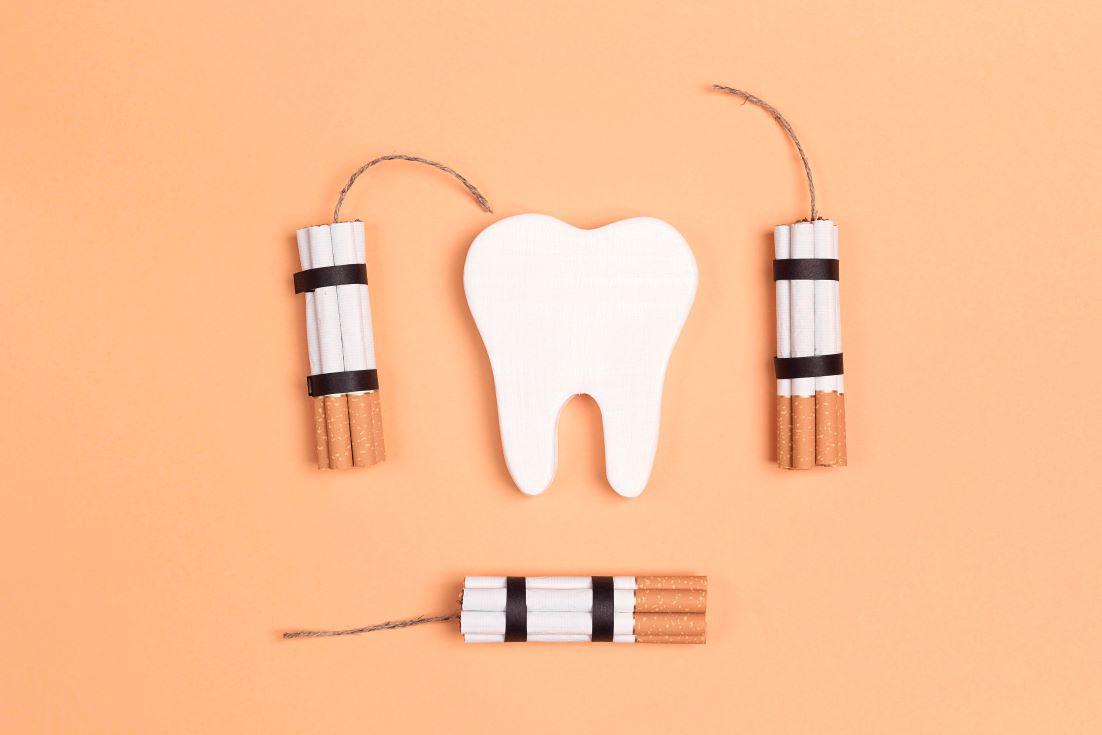 It’s no secret that smoking is bad for your health. According to the CDC, “Cigarette smoking is the leading cause of preventable death in the United States.” The list of health issues linked to smoking includes:
It’s no secret that smoking is bad for your health. According to the CDC, “Cigarette smoking is the leading cause of preventable death in the United States.” The list of health issues linked to smoking includes:
- Coronary heart disease
- Stroke
- Lung cancer
- Cardiovascular disease
- Respiratory disease
- Cancer anywhere in almost any part of the body
- Difficult becoming pregnant
- Early delivery
- Stillbirth
- Ectopic pregnancy
- Orofacial clefts in infants
When it comes to oral health, smoking has several consequences, including:
- Dental staining
- Gum disease
- Tooth loss
- Mouth cancer
This blog discusses the effects of smoking on your teeth and oral health.
Dental Staining
Tooth stains caused by cigarette smoke may be yellow, brown, dark brown, or black. When the goal is to have a bright, white smile, this can be discouraging and may even lead to social disadvantages.
It is the combination of nicotine and tar in the tobacco that causes the enamel on the teeth to become discolored. Over time, these elements soak into the enamel through microscopic pores, leading to discoloration.
The best way to prevent dental staining from cigarettes is to quit smoking (and using tobacco in general). Other ways to prevent major dental stains are to maintain proper oral hygiene, brush after each cigarette, and visit your dentist for regular check-ups and cleanings.
To restore tobacco-stained teeth, professional whitening treatments or porcelain veneers may be an option. However, it’s important to remember that whitened teeth will become yellowed again if you continue to smoke.
Gum Disease
According to the CDC, smokers are nearly twice as likely to suffer from gum disease than non-smokers.
Gum disease, or periodontal disease, is an inflammatory disease that affects the gingiva, alveolar bone, and periodontal ligaments (the tissues that support your teeth). There are three stages of periodontal disease:
-
Gingivitis: characterized mainly by swollen gums
-
Moderate periodontitis: characterized by bone loss and pockets of bacteria along the gum line
-
Advanced periodontitis: characterized by further bone loss and deeper periodontal pockets
Smokers are at a higher risk for gum disease for three reasons:
-
Dry mouth. Smoking reduces saliva production, leading to a dry oral environment. This makes it easier for bad bacteria to attach to your teeth and gums.
-
Smoking weakens your body’s ability to fight off infection. Once the disease has begun to develop, your body has a harder time fighting off the infection, so it’s more likely to progress to more advanced stages of gum disease.
-
People who smoke typically have poor circulation. Vasoconstriction, or constriction of the blood vessels, inhibits the gum tissue’s ability to stay healthy and resist infection.
Tooth Loss
Years of smoking and poor oral health can lead to tooth loss. Smoking causes a domino effect on your oral health.
For example, if you develop gingivitis, because of the conditions we discussed earlier, it will likely turn into advanced periodontitis. During this stage of gum disease, the jawbone, gum tissue, and ligaments continue to deteriorate, making the teeth loose. Eventually, there will be no support for the teeth, and they will fall out.
Studies have shown that female smokers lose, on average, 1.5 teeth every 10 years, and male smokers lose 2.9 teeth every 10 years. You don’t have to become a part of this statistic. Stop smoking today!
Mouth Cancer
Cigarettes and other tobacco products contain toxins, carcinogens, and nicotine, which contribute to their cancer-causing abilities. Mouth cancer is where a tumor develops on the surface of the tongue, the inside of the cheeks, the roof of the mouth, lips, or gums. Tumors may also develop on the salivary glands, tonsils, or throat.
According to Johns Hopkins Medicine, smokers are 10 times more likely to develop mouth cancer than non-smokers. Caught early, 9 in 10 cases are completely cured by surgery. This is yet another reason to visit your dentist at least every six months.
Symptoms of mouth cancer include:
- Mouth ulcers
- Lumps in the mouth or neck that do not go away
- Unexplained loose teeth
- Numbness or an odd feeling on the lip or tongue
- White or red patches on the lining of the tongue
- Changes in speech
If you experience any of these symptoms, contact your dentist or general practitioner as soon as possible.
Need help quitting smoking?
Visit with a dental professional today. We implore all of our patients who smoke to quit immediately. Over time, the health risks mentioned above are significantly reduced and your oral health will improve within one year.
For more encouragement and tips on how to quit smoking, schedule an appointment with our friendly dental team today.


